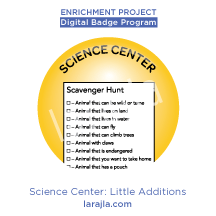 Little additions give kids another way to learn science without exhibits. Here are some that you might add to your center or even create a general activity room.
Little additions give kids another way to learn science without exhibits. Here are some that you might add to your center or even create a general activity room.
NOTE: Some little additions are included with the “Science Center X” badge programs as supplements.
Steps
1. Map.
A map can help your visitors move around your center, find out-of-the-way exhibits and more. You can also map out the exhibit itself. How can you include maps in your exhibit?
2. Scavenger hunt.
We did a scavenger hunt years ago at the Adler Planetarium in Chicago. The girls loved it. They were more involved in the exhibits because completing the scavenger hunt made them pay attention.
Scavenger hunts can be created for specific areas of study, highlighting those exhibits that fit with current interests. Can you incorporate a scavenger hunt? Don’t make it too hard so your visitors get frustrated.
3. Play area.
Play areas can be adapted to the theme you are developing. For a light theme, you can create a maze in your play area that has to be navigated with flashlights. For a detective theme, you have to solve clues to get to the next area. How might you create an play area for your theme?
4. Word walls.
Introducing new topics might be challenging to some visitors. Making a word wall adds a visual element so the kids can see the words as well as hear them.
5. Coloring pages.
Your coloring pages don’t have to just be of birds and turtles. Instead, a head shot of a famous scientist near an exhibit about them with a brief description would add value to your exhibit and give them something to take home. A coloring sheet with items in order for an experiment they can duplicate at home would give them the opportunity to do it again with their family. How might you take a plain “coloring sheet” and make it more informative?
6. Word search.
When you’re learning a new branch of science, or just about anything else, familiarity with the jargon can be helpful. A word search is a simple way to make the words accessible and your visitors can ask about the words they don’t know. Be sure to make your word searches age specific.
7. Puzzles and games.
Simple puzzles and games make great printables. If it is something you’d like to use over, laminate the sheet. Find some puzzles and games that your kids might enjoy.
8. Small activities.
You can plan small activities for a group to build excitement before going into the Science Center, refocus them after their trip or even to help explain more difficult concepts. Boxed activities can have one set that your audience can view while you’re doing it or they can each do their own experiments like testing the pH of various materials.
These activities might be parts of your Science Center that can be borrowed or moved.
9. Service.
You can incorporate service into your Science Center. For example, if you’re growing herbs and vegetables, you can donate them to local food shelters. You can ask for a donation for an animal shelter as payment to attend. How else might you incorporate service into your activities?
10. Science library.
Donations of books might have you looking at providing a science library. Not only could it be used on-site, individual books could be “checked out” by schools and youth organizations when they’re working on their own science explorations.
11. Brainstorm.
What other additions might you be able to include in your Science Center?
Sites to Explore
To download a PDF of this badge program, click here: EP_SC03_Little Additions
Leave a Reply